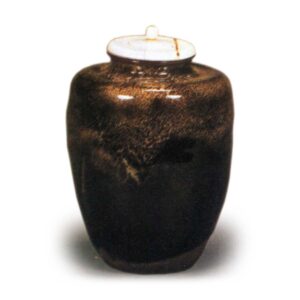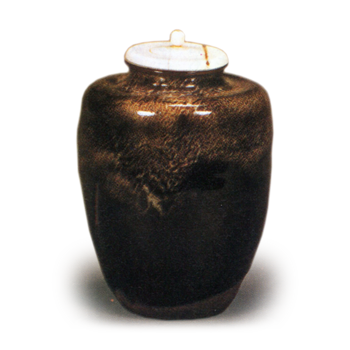
A great masterpiece. This tea caddy was made in the Han style. It was originally called “Ariake katatsuki” and was the treasured possession of Toyotomi Hideyoshi, but Hosokawa Sansai received it. However, due to financial difficulties, Sansai relinquished it, and it came into the possession of Ankokuji Keikei, who called it Ankokuji hara-jyu. After the Battle of Sekigahara, Keikei was executed at Shijo Kawara in Kyoto, and this tea container was given by Tokugawa Ieyasu to Tsuda Koheiji Hidemasa according to a promise before the battle. One day, when invited to Tsuda’s tea ceremony, Sanzai met this tea master for the first time in a long time and could not help feeling affection for him. Sanzai’s heart was exactly like the heart of this poem. This is why this tea caddy is also known as “Nakayama kagashu” (meaning “the mountain in the middle of the night”). After returning home, Sanzai sent a messenger with 200 pieces of gold, a piece of ceremonial dress, and some sake and snacks, apologizing for his rudeness and requesting that the tea caddy be given to him again. In 1627, during a famine in Kokura in his domain of Buzen Province (Fukuoka Prefecture), Hosokawa Tadatoshi converted the gold into 1,500 pieces of gold and saved the starving people with them. Sanzai, who was in Edo, heard of this and praised Tadatoshi’s improvement in the tea ceremony. In 1865, his son Tadatoshi presented the tea caddy to the shogunate, and it was later given to Matsudaira Iga-no-Mamoru, lord of Ueda Castle. It had been in the family since then, but when the family sold it in 1913 (Taisho 2), it was sold to Masuda Benizen. It was sold to Masuda Beniyo for only 800 yen because it was almost naked and did not attract much attention. The characteristic of this tea caddy is the white rat-colored flecks all over the black candy-colored glaze. (Hosokawa Sansai Nenpu, Toshogu Goshiki Appendix, Chayu Kojidan, Chaji Hinroku, Bukke Shichitoku, Taisho Meikikan)



